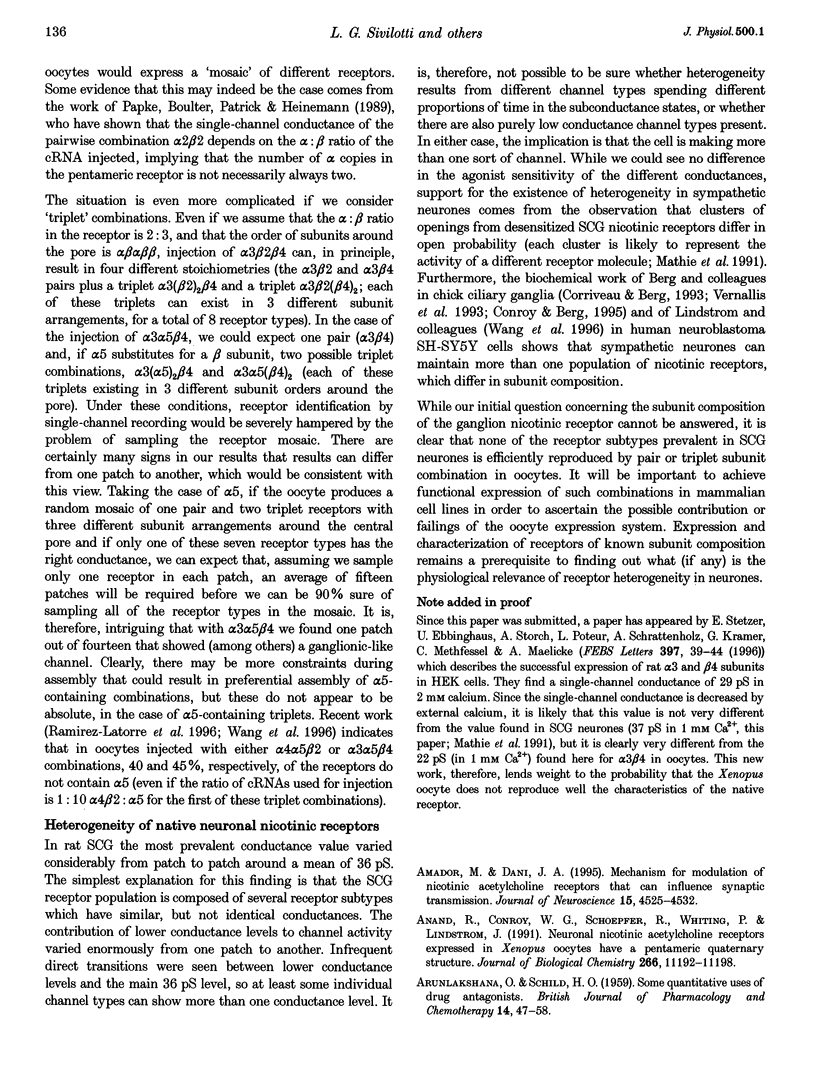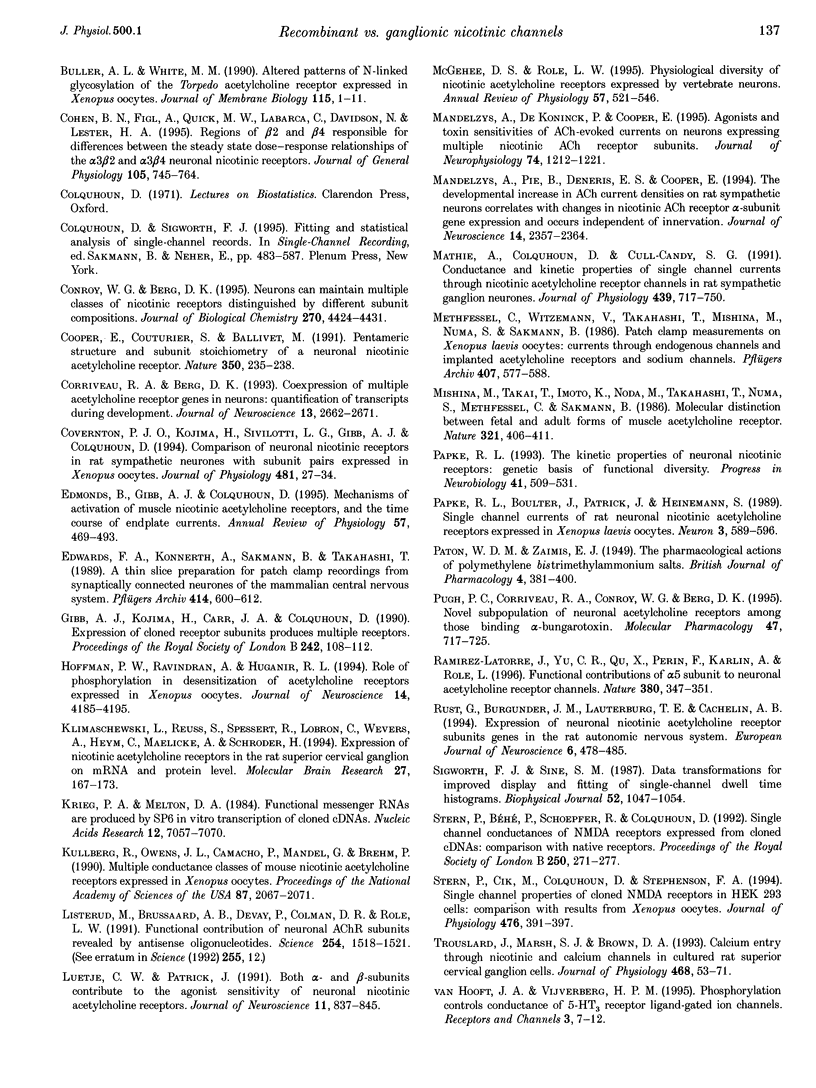Abstract
1. In order to establish the subunit composition of neuronal nicotinic receptors in rat superior cervical ganglia (SCG), their single-channel properties were compared with those of recombinant receptors expressed in Xenopus oocytes, using outside-out excised patch recording. 2. The mean main conductance of SCG channels from adult and 1-day-old rats was 34.8 and 36.6 pS, respectively. Less frequent openings to lower conductances occurred both as isolated bursts and as events connected to the main level by direct transitions. There was considerable interpatch variability in the values of the lower conductances. 3. Nicotinic receptors from oocytes expressing alpha3beta4 and alpha4beta4 subunits had chord conductances lower than that of SCG neurones (22 pS for alpha3beta4 and 29 pS for alpha4beta4). 4. Prolonged recording from both native and recombinant channels was precluded by 'run-down', i.e. channel activity could be elicited for only a few minutes after excision. Nevertheless, SCG channel openings were clearly seen to occur as short bursts (slowest component, 38 ms), whereas recombinant channels opened in very prolonged bursts of activity, the major component being the slowest (480 ms). 5. Addition of the alpha5 subunit to the alpha3beta4 pair produced channels with a higher conductance than those observed after injection of the pair alone (24.9 vs. 22 pS), suggesting incorporation of alpha5 into the channel. Addition of the beta2 subunit did not change alpha3beta4 single-channel properties. In one out of fourteen alpha3alpha5beta4 patches, both ganglion-like, high conductance, short burst openings and recombinant-type, low conductance, slow burst openings were observed. 6. Channels produced by expression in Xenopus oocytes of neuronal nicotinic subunits present in rat SCG as a rule differ from native ganglion receptors in single-channel conductance and gross kinetics. While it is possible that an essential nicotinic subunit remains to be cloned, it is perhaps more likely that oocytes either cannot assemble neuronal nicotinic subunits efficiently into channels with the correct composition and stoichiometry, or that they produce post-translational channel modifications which differ from those of mammalian neurones.
Full text
PDF















Selected References
These references are in PubMed. This may not be the complete list of references from this article.
- ARUNLAKSHANA O., SCHILD H. O. Some quantitative uses of drug antagonists. Br J Pharmacol Chemother. 1959 Mar;14(1):48–58. doi: 10.1111/j.1476-5381.1959.tb00928.x. [DOI] [PMC free article] [PubMed] [Google Scholar]
- Amador M., Dani J. A. Mechanism for modulation of nicotinic acetylcholine receptors that can influence synaptic transmission. J Neurosci. 1995 Jun;15(6):4525–4532. doi: 10.1523/JNEUROSCI.15-06-04525.1995. [DOI] [PMC free article] [PubMed] [Google Scholar]
- Anand R., Conroy W. G., Schoepfer R., Whiting P., Lindstrom J. Neuronal nicotinic acetylcholine receptors expressed in Xenopus oocytes have a pentameric quaternary structure. J Biol Chem. 1991 Jun 15;266(17):11192–11198. [PubMed] [Google Scholar]
- Cohen B. N., Figl A., Quick M. W., Labarca C., Davidson N., Lester H. A. Regions of beta 2 and beta 4 responsible for differences between the steady state dose-response relationships of the alpha 3 beta 2 and alpha 3 beta 4 neuronal nicotinic receptors. J Gen Physiol. 1995 Jun;105(6):745–764. doi: 10.1085/jgp.105.6.745. [DOI] [PMC free article] [PubMed] [Google Scholar]
- Conroy W. G., Berg D. K. Neurons can maintain multiple classes of nicotinic acetylcholine receptors distinguished by different subunit compositions. J Biol Chem. 1995 Mar 3;270(9):4424–4431. doi: 10.1074/jbc.270.9.4424. [DOI] [PubMed] [Google Scholar]
- Cooper E., Couturier S., Ballivet M. Pentameric structure and subunit stoichiometry of a neuronal nicotinic acetylcholine receptor. Nature. 1991 Mar 21;350(6315):235–238. doi: 10.1038/350235a0. [DOI] [PubMed] [Google Scholar]
- Corriveau R. A., Berg D. K. Coexpression of multiple acetylcholine receptor genes in neurons: quantification of transcripts during development. J Neurosci. 1993 Jun;13(6):2662–2671. doi: 10.1523/JNEUROSCI.13-06-02662.1993. [DOI] [PMC free article] [PubMed] [Google Scholar]
- Covernton P. J., Kojima H., Sivilotti L. G., Gibb A. J., Colquhoun D. Comparison of neuronal nicotinic receptors in rat sympathetic neurones with subunit pairs expressed in Xenopus oocytes. J Physiol. 1994 Nov 15;481(Pt 1):27–34. doi: 10.1113/jphysiol.1994.sp020416. [DOI] [PMC free article] [PubMed] [Google Scholar]
- Edmonds B., Gibb A. J., Colquhoun D. Mechanisms of activation of muscle nicotinic acetylcholine receptors and the time course of endplate currents. Annu Rev Physiol. 1995;57:469–493. doi: 10.1146/annurev.ph.57.030195.002345. [DOI] [PubMed] [Google Scholar]
- Edwards F. A., Konnerth A., Sakmann B., Takahashi T. A thin slice preparation for patch clamp recordings from neurones of the mammalian central nervous system. Pflugers Arch. 1989 Sep;414(5):600–612. doi: 10.1007/BF00580998. [DOI] [PubMed] [Google Scholar]
- Eisenberg R. S. Channels as enzymes. J Membr Biol. 1990 Apr;115(1):1–12. doi: 10.1007/BF01869101. [DOI] [PubMed] [Google Scholar]
- Gibb A. J., Kojima H., Carr J. A., Colquhoun D. Expression of cloned receptor subunits produces multiple receptors. Proc Biol Sci. 1990 Nov 22;242(1304):108–112. doi: 10.1098/rspb.1990.0112. [DOI] [PubMed] [Google Scholar]
- Hoffman P. W., Ravindran A., Huganir R. L. Role of phosphorylation in desensitization of acetylcholine receptors expressed in Xenopus oocytes. J Neurosci. 1994 Jul;14(7):4185–4195. doi: 10.1523/JNEUROSCI.14-07-04185.1994. [DOI] [PMC free article] [PubMed] [Google Scholar]
- Klimaschewski L., Reuss S., Spessert R., Lobron C., Wevers A., Heym C., Maelicke A., Schröder H. Expression of nicotinic acetylcholine receptors in the rat superior cervical ganglion on mRNA and protein level. Brain Res Mol Brain Res. 1994 Nov;27(1):167–173. doi: 10.1016/0169-328x(94)90199-6. [DOI] [PubMed] [Google Scholar]
- Krieg P. A., Melton D. A. Functional messenger RNAs are produced by SP6 in vitro transcription of cloned cDNAs. Nucleic Acids Res. 1984 Sep 25;12(18):7057–7070. doi: 10.1093/nar/12.18.7057. [DOI] [PMC free article] [PubMed] [Google Scholar]
- Kullberg R., Owens J. L., Camacho P., Mandel G., Brehm P. Multiple conductance classes of mouse nicotinic acetylcholine receptors expressed in Xenopus oocytes. Proc Natl Acad Sci U S A. 1990 Mar;87(6):2067–2071. doi: 10.1073/pnas.87.6.2067. [DOI] [PMC free article] [PubMed] [Google Scholar]
- Listerud M., Brussaard A. B., Devay P., Colman D. R., Role L. W. Functional contribution of neuronal AChR subunits revealed by antisense oligonucleotides. Science. 1991 Dec 6;254(5037):1518–1521. doi: 10.1126/science.1720573. [DOI] [PMC free article] [PubMed] [Google Scholar]
- Luetje C. W., Patrick J. Both alpha- and beta-subunits contribute to the agonist sensitivity of neuronal nicotinic acetylcholine receptors. J Neurosci. 1991 Mar;11(3):837–845. doi: 10.1523/JNEUROSCI.11-03-00837.1991. [DOI] [PMC free article] [PubMed] [Google Scholar]
- Mandelzys A., De Koninck P., Cooper E. Agonist and toxin sensitivities of ACh-evoked currents on neurons expressing multiple nicotinic ACh receptor subunits. J Neurophysiol. 1995 Sep;74(3):1212–1221. doi: 10.1152/jn.1995.74.3.1212. [DOI] [PubMed] [Google Scholar]
- Mandelzys A., Pié B., Deneris E. S., Cooper E. The developmental increase in ACh current densities on rat sympathetic neurons correlates with changes in nicotinic ACh receptor alpha-subunit gene expression and occurs independent of innervation. J Neurosci. 1994 Apr;14(4):2357–2364. doi: 10.1523/JNEUROSCI.14-04-02357.1994. [DOI] [PMC free article] [PubMed] [Google Scholar]
- Mathie A., Cull-Candy S. G., Colquhoun D. Conductance and kinetic properties of single nicotinic acetylcholine receptor channels in rat sympathetic neurones. J Physiol. 1991 Aug;439:717–750. doi: 10.1113/jphysiol.1991.sp018690. [DOI] [PMC free article] [PubMed] [Google Scholar]
- McGehee D. S., Role L. W. Physiological diversity of nicotinic acetylcholine receptors expressed by vertebrate neurons. Annu Rev Physiol. 1995;57:521–546. doi: 10.1146/annurev.ph.57.030195.002513. [DOI] [PubMed] [Google Scholar]
- Methfessel C., Witzemann V., Takahashi T., Mishina M., Numa S., Sakmann B. Patch clamp measurements on Xenopus laevis oocytes: currents through endogenous channels and implanted acetylcholine receptor and sodium channels. Pflugers Arch. 1986 Dec;407(6):577–588. doi: 10.1007/BF00582635. [DOI] [PubMed] [Google Scholar]
- Mishina M., Takai T., Imoto K., Noda M., Takahashi T., Numa S., Methfessel C., Sakmann B. Molecular distinction between fetal and adult forms of muscle acetylcholine receptor. Nature. 1986 May 22;321(6068):406–411. doi: 10.1038/321406a0. [DOI] [PubMed] [Google Scholar]
- Papke R. L., Boulter J., Patrick J., Heinemann S. Single-channel currents of rat neuronal nicotinic acetylcholine receptors expressed in Xenopus oocytes. Neuron. 1989 Nov;3(5):589–596. doi: 10.1016/0896-6273(89)90269-9. [DOI] [PubMed] [Google Scholar]
- Papke R. L. The kinetic properties of neuronal nicotinic receptors: genetic basis of functional diversity. Prog Neurobiol. 1993 Oct;41(4):509–531. doi: 10.1016/0301-0082(93)90028-q. [DOI] [PubMed] [Google Scholar]
- Pugh P. C., Corriveau R. A., Conroy W. G., Berg D. K. Novel subpopulation of neuronal acetylcholine receptors among those binding alpha-bungarotoxin. Mol Pharmacol. 1995 Apr;47(4):717–725. [PubMed] [Google Scholar]
- Ramirez-Latorre J., Yu C. R., Qu X., Perin F., Karlin A., Role L. Functional contributions of alpha5 subunit to neuronal acetylcholine receptor channels. Nature. 1996 Mar 28;380(6572):347–351. doi: 10.1038/380347a0. [DOI] [PubMed] [Google Scholar]
- Rust G., Burgunder J. M., Lauterburg T. E., Cachelin A. B. Expression of neuronal nicotinic acetylcholine receptor subunit genes in the rat autonomic nervous system. Eur J Neurosci. 1994 Mar 1;6(3):478–485. doi: 10.1111/j.1460-9568.1994.tb00290.x. [DOI] [PubMed] [Google Scholar]
- Sigworth F. J., Sine S. M. Data transformations for improved display and fitting of single-channel dwell time histograms. Biophys J. 1987 Dec;52(6):1047–1054. doi: 10.1016/S0006-3495(87)83298-8. [DOI] [PMC free article] [PubMed] [Google Scholar]
- Stern P., Béhé P., Schoepfer R., Colquhoun D. Single-channel conductances of NMDA receptors expressed from cloned cDNAs: comparison with native receptors. Proc Biol Sci. 1992 Dec 22;250(1329):271–277. doi: 10.1098/rspb.1992.0159. [DOI] [PubMed] [Google Scholar]
- Stern P., Cik M., Colquhoun D., Stephenson F. A. Single channel properties of cloned NMDA receptors in a human cell line: comparison with results from Xenopus oocytes. J Physiol. 1994 May 1;476(3):391–397. doi: 10.1113/jphysiol.1994.sp020140. [DOI] [PMC free article] [PubMed] [Google Scholar]
- Stetzer E., Ebbinghaus U., Storch A., Poteur L., Schrattenholz A., Kramer G., Methfessel C., Maelicke A. Stable expression in HEK-293 cells of the rat alpha3/beta4 subtype of neuronal nicotinic acetylcholine receptor. FEBS Lett. 1996 Nov 11;397(1):39–44. doi: 10.1016/s0014-5793(96)01115-5. [DOI] [PubMed] [Google Scholar]
- Trouslard J., Marsh S. J., Brown D. A. Calcium entry through nicotinic receptor channels and calcium channels in cultured rat superior cervical ganglion cells. J Physiol. 1993 Aug;468:53–71. doi: 10.1113/jphysiol.1993.sp019759. [DOI] [PMC free article] [PubMed] [Google Scholar]
- Van Hooft J. A., Vijverberg H. P. Phosphorylation controls conductance of 5-HT3 receptor ligand-gated ion channels. Receptors Channels. 1995;3(1):7–12. [PubMed] [Google Scholar]
- Vernallis A. B., Conroy W. G., Berg D. K. Neurons assemble acetylcholine receptors with as many as three kinds of subunits while maintaining subunit segregation among receptor subtypes. Neuron. 1993 Mar;10(3):451–464. doi: 10.1016/0896-6273(93)90333-m. [DOI] [PubMed] [Google Scholar]
- Wang F., Gerzanich V., Wells G. B., Anand R., Peng X., Keyser K., Lindstrom J. Assembly of human neuronal nicotinic receptor alpha5 subunits with alpha3, beta2, and beta4 subunits. J Biol Chem. 1996 Jul 26;271(30):17656–17665. doi: 10.1074/jbc.271.30.17656. [DOI] [PubMed] [Google Scholar]
- Wong E. T., Holstad S. G., Mennerick S. J., Hong S. E., Zorumski C. F., Isenberg K. E. Pharmacological and physiological properties of a putative ganglionic nicotinic receptor, alpha 3 beta 4, expressed in transfected eucaryotic cells. Brain Res Mol Brain Res. 1995 Jan;28(1):101–109. doi: 10.1016/0169-328x(94)00189-l. [DOI] [PubMed] [Google Scholar]
- Wyllie D. J., Béhé P., Nassar M., Schoepfer R., Colquhoun D. Single-channel currents from recombinant NMDA NR1a/NR2D receptors expressed in Xenopus oocytes. Proc Biol Sci. 1996 Aug 22;263(1373):1079–1086. doi: 10.1098/rspb.1996.0159. [DOI] [PubMed] [Google Scholar]
- Yu X. M., Hall Z. W. Extracellular domains mediating epsilon subunit interactions of muscle acetylcholine receptor. Nature. 1991 Jul 4;352(6330):64–67. doi: 10.1038/352064a0. [DOI] [PubMed] [Google Scholar]
- Zoli M., Le Novère N., Hill J. A., Jr, Changeux J. P. Developmental regulation of nicotinic ACh receptor subunit mRNAs in the rat central and peripheral nervous systems. J Neurosci. 1995 Mar;15(3 Pt 1):1912–1939. doi: 10.1523/JNEUROSCI.15-03-01912.1995. [DOI] [PMC free article] [PubMed] [Google Scholar]
- Zwart R., Oortgiesen M., Vijverberg H. P. Differential modulation of alpha 3 beta 2 and alpha 3 beta 4 neuronal nicotinic receptors expressed in Xenopus oocytes by flufenamic acid and niflumic acid. J Neurosci. 1995 Mar;15(3 Pt 2):2168–2178. doi: 10.1523/JNEUROSCI.15-03-02168.1995. [DOI] [PMC free article] [PubMed] [Google Scholar]


